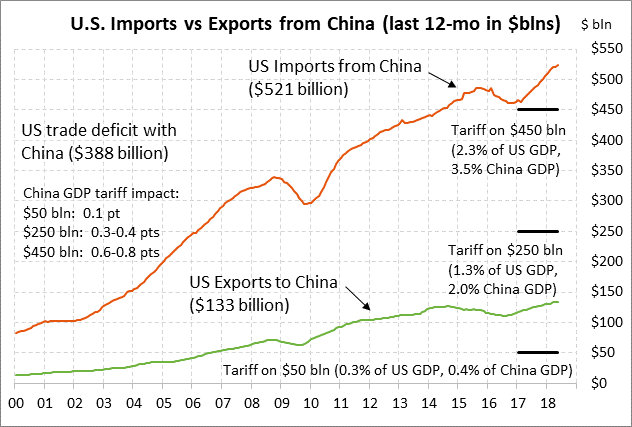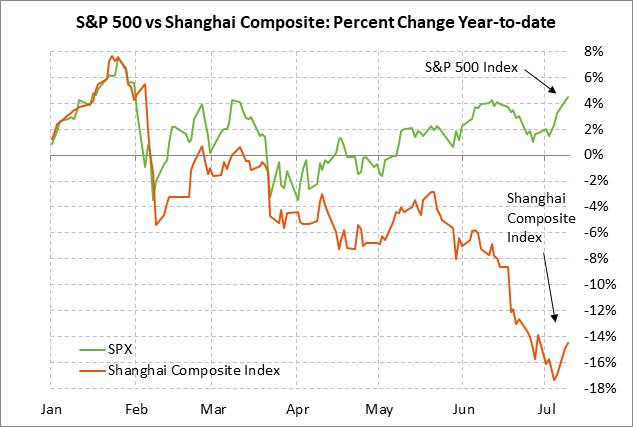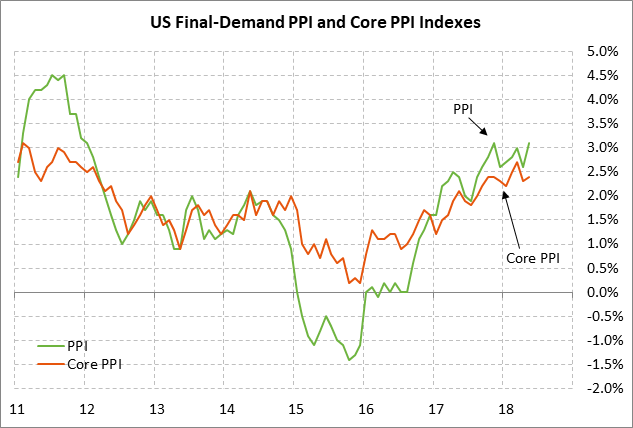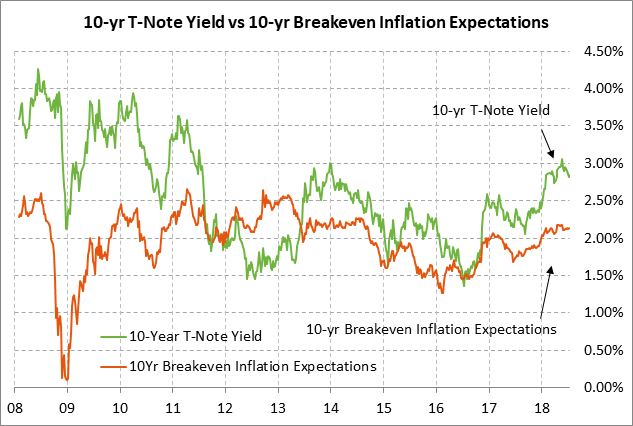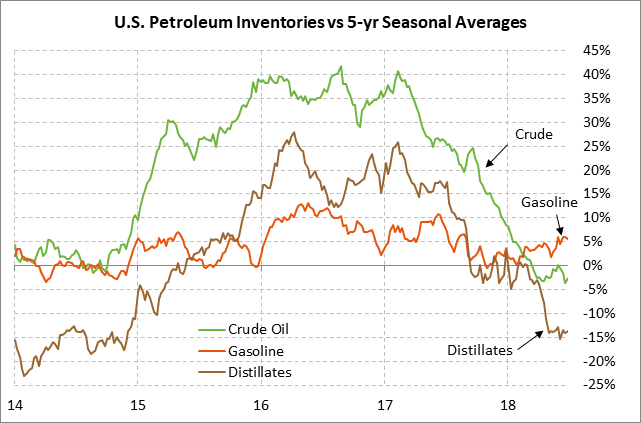- Trump administration dramatically escalates U.S./Chinese trade war with $200 billion more Chinese products slated for tariffs
- U.S. PPI expected to remain at 6-1/2 year high
- 10-year T-note auction to yield near 2.86%
- EIA weekly report
Trump administration dramatically escalates U.S./Chinese trade war with $200 billion more Chinese products slated for tariffs — The Trump administration late Tuesday released a list of $200 billion of Chinese products that will be subject to a 10% tariff. The new product list will be subject to a public comment period of about 2 months, which means that the tariffs could be implemented as soon as September if there isn’t a U.S./Chinese trade compromise in the meantime.
The U.S. and China just exchanged tariffs on $34 billion worth of products on July 6 and another $16 billion tranche is expected to be implemented later this summer. Chinese officials do not seem to be particularly alarmed about tariffs on that $50 billion worth of products. However, an additional $200 billion tranche represents a much more serious matter since the U.S. would then have tariffs on about half of the $520 billion worth of Chinese goods that the U.S. has imported over the past 12 months. The tariffs on $250 billion of Chinese goods would amount to about 1.3% of U.S. GDP and 2.0% of Chinese GDP. Tariffs at that scale could cause a 0.3-0.4 point hit to Chinese GDP and could cause enough upward pressure on U.S. inflation to force the Fed into additional rate hikes.
The fact that the Trump administration is escalating its trade war against China so quickly is a major concern for the markets. China has only $130 billion worth of U.S. imports to retaliate against, which means that China cannot fully retaliate against U.S. tariffs on $250 billion of Chinese goods. At that point, China would either have to absorb the blow or resort to non-tariff punishments such as (1) strangling sales of U.S. companies operating within China, (2) organizing consumer boycotts against U.S. brands, (3) depreciating the yuan, or (4) cutting China’s holdings of $1.2 trillion worth of Treasury securities.
If stocks are used as a measuring stick, then China is suffering more than the U.S. from trade tensions. On a year-to-date basis, the Shanghai Composite index is down by -14.5% and plunged to a 2-1/4 year low last Friday, whereas the S&P 500 index is up +4.5%. However, there is still plenty of room for U.S. stocks to fall as the U.S. trade war against the world heats up, particularly since the Fed is in the midst of a double-barreled tightening move with both higher interest rates and a falling balance sheet. A worsening trade war would suggest stagflation for the U.S. with lower GDP growth and higher inflation.
U.S. PPI expected to remain at 6-1/2 year high — The market consensus is for today’s June final-demand PPI to be unchanged from May’s 6-1/2 year high of +3.1% y/y. Meanwhile, today’s June core PPI is expected to rise to +2.6% y/y from May’s +2.4%, stopping just 0.1 point below March’s 6-3/4 year high of +2.7%.
Today’s expected PPI report of +3.1% would show that U.S. wholesale inflation is well above the Fed’s +2.0% inflation target and is putting upward pressure on the overall U.S. inflation rate. There is upward pressure on inflation due to (1) strong economic growth with Q2 GDP expected above +3.4%, (2) the recent 3-1/2 year high in oil prices, (3) strong metals and material input prices, and (4) upward price pressure from U.S. tariffs on a range of imported products.
Meanwhile, the PCE deflator, which is the Fed’s preferred inflation measure, rose in May to a new 6-year high of +2.3% y/y headline and +2.0% y/y core. The Fed has said that it will tolerate a mild overshoot of its 2.0% inflation target since its target is symmetrical. However, it is possible that the U.S. inflation rate will rise farther above the Fed’s target due to the various upward pressures, thus putting the Fed behind the inflation curve. That increases the chance of the fourth Fed rate hike of the year in December and could force the Fed into more rate hikes in 2019 than the market is currently expecting.
10-year T-note auction to yield near 2.86% — The Treasury today will sell $22 billion of 10-year T-notes in the second and final reopening of the 2-7/8% 10-year note of May 2028 that the Treasury first sold in May. The Treasury will then conclude this week’s $69 billion coupon package by selling $14 billion of 30-year bonds on Thursday. The markets will be a bit nervous going into today’s 10-year T-note auction given the weak results at Tuesday’s 3-year T-note auction.
Today’s 10-year T-note issue was trading at 2.86% in when-issued trading late yesterday afternoon. That translates to an inflation-adjusted yield of 0.73% against the current 10-year breakeven inflation expectations rate of 2.13%. The 10-year T-note yield has fallen by -27 bp to 2.86% from May’s 7-year high of 3.13% mainly because of trade tensions and reduced expectations for Fed rate hikes.
The 12-auction averages for the 10-year are as follows: 2.46 bid cover ratio, $19 million of non-competitive bids taken mostly by retail investors, 4.8 bp tail to the median yield, 16.7 bp tail to the low yield, and 49% taken at the high yield. The 10-year is a little below average in popularity among foreign investors and central banks. Indirect bidders, a proxy for foreign buyers, have taken an average of 62.5% of the last twelve 10-year T-note auctions, which is mildly below the median of 63.3% for all recent coupon auctions.
EIA weekly report — The market consensus for today’s weekly EIA report is for a -4.0 mln bbl decline in U.S. crude oil inventories, a -1.0 mln bbl decline in gasoline inventories, a +1.0 mln bbl rise in distillate inventories, and a +0.2 point rise in the U.S. refinery utilization rate to 97.3%. U.S. oil production last week was unchanged at a record high of 10.9 mln bpd.

